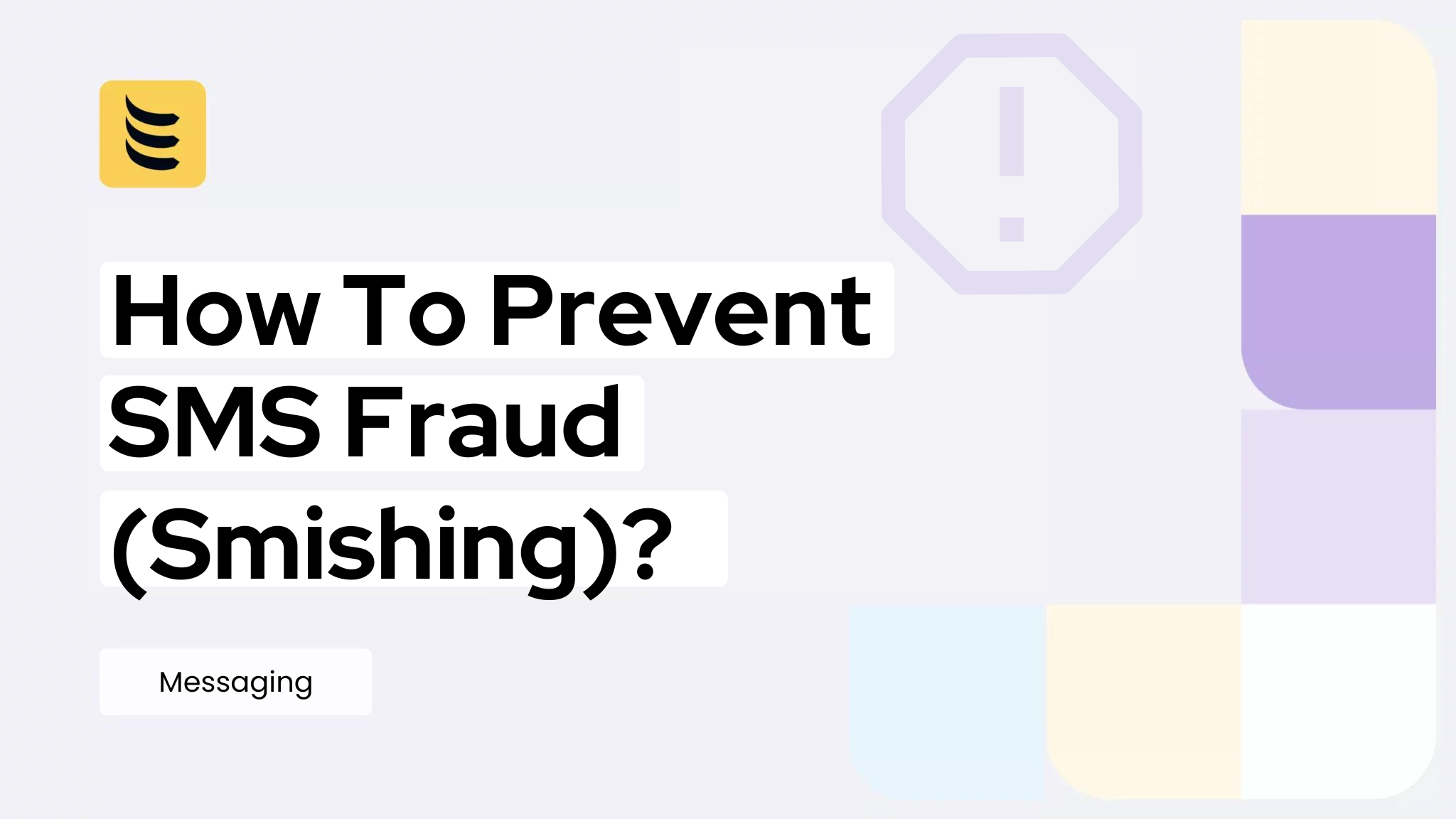SMS remains one of the most effective ways for businesses to engage with customers, whether for authentication, marketing, or transactional alerts. However, as SMS usage grows, so does the risk of smishing (SMS phishing)—a form of fraud where attackers impersonate trusted brands to steal sensitive data. For businesses relying on SMS communication, falling victim to smishing can lead to financial losses, eroded customer trust, and reputational damage. Understanding how smishing works and implementing strong security measures is critical to safeguarding both your business and your customers.
The Rising Threat of Smishing: Why Businesses Using SMS Are at Risk
Cybercriminals increasingly target SMS because it is a direct and widely trusted communication channel. Unlike email, where spam filters are advanced, many users and businesses still treat text messages as inherently secure. This false sense of security makes SMS an attractive vector for fraud. Attackers exploit this trust by sending fake messages that appear to come from legitimate sources—banks, delivery services, or even your own company. Once a customer clicks a malicious link or shares personal information, the damage is done. For businesses, the consequences go beyond a single compromised account. A successful smishing attack can lead to chargebacks, regulatory penalties, and long-term brand erosion. The risk is especially high for industries like banking, e-commerce, and healthcare, where SMS is often used for sensitive communications.
How Smishing Works: Common Scams Targeting Your Customers
Smishing attacks succeed because they exploit human psychology—urgency, fear, and trust in recognizable brands. Cybercriminals impersonate legitimate businesses, government agencies, or even colleagues to trick victims into revealing sensitive information or downloading malware. The messages often appear convincing, using official-sounding language, familiar sender names, and deceptive links.
Fake OTP and Account Verification Scams
One of the most prevalent smishing tactics involves sending fake one-time password (OTP) requests. A customer might receive a text that appears to come from their bank, saying:
“Your account has been locked due to suspicious activity. To verify your identity, click here: [malicious link]”
The link leads to a phishing site designed to steal login credentials. In some cases, the scammer follows up with a call pretending to be customer support, asking the victim to read aloud the real OTP sent by the actual bank—giving the fraudster full account access.
Delivery and Package Scams (Fake Courier Messages)
With the rise of e-commerce, fake delivery notifications have become a favorite among smishers. These messages often mimic major courier services like FedEx, UPS, or DHL, claiming:
“Your package is on hold due to an incomplete address. Update your details now: [fraudulent link]”
Customers who click the link may be prompted to enter personal information or pay a small “redelivery fee,” which actually steals their payment details. Some scams even infect devices with malware if a user downloads a fake “shipping label” attachment.
“Your Subscription Has Expired” or “Payment Failed” Scams
Another common tactic is sending fake renewal or payment alerts, such as:
“Netflix: Your subscription has expired. Update your payment method to avoid service interruption: [phishing link]”
These messages pressure users into acting quickly, making them more likely to enter credit card details on a fraudulent site. Since many people have multiple subscriptions, they may not immediately recognize the scam.
CEO Fraud and Internal Impersonation Scams
Businesses aren’t just at risk from external threats—employees can also fall victim to smishing. A classic example is the “CEO scam,” where an attacker poses as an executive texting an employee:
“Hi [Employee Name], I need you to buy gift cards for a client meeting ASAP. Please send the codes to this number when done.”
Because the message appears to come from a high-ranking official, employees may comply without verification, leading to financial losses for the company.
How to Spot and Stop These Attacks
While smishing scams vary, they often share red flags:
- Urgent language (“Act now or your account will be closed!”)
- Unusual sender numbers (e.g., a foreign number claiming to be a local bank)
- Shortened or misspelled links (e.g., “bankofamerica.secure-login.com” instead of “bankofamerica.com”)
Businesses can protect customers by:
- Using branded sender IDs instead of generic numbers.
- Avoiding clickable links in sensitive messages (e.g., directing users to log in via an official app).
- Educating customers about smishing risks in SMS campaigns.
By understanding these tactics, companies can better secure their SMS communications—and help customers stay vigilant.
Protecting Your Business: SMS Security Best Practices for Enterprises
To defend against smishing, businesses must implement strong technical and operational safeguards. One of the most effective steps is sender ID authentication, ensuring that only authorized parties can send messages under your brand name. Technologies like SMS firewalls and fraud detection systems can analyze traffic in real-time, blocking suspicious messages before they reach customers. Encryption should also be a priority, especially for messages containing sensitive data like OTPs or payment links. Additionally, businesses should limit the use of clickable links in SMS, instead directing customers to official apps or websites where possible. Regular audits of SMS traffic can help detect anomalies, such as unexpected spikes in message volume or unauthorized sender IDs. By adopting these measures, companies can significantly reduce their exposure to smishing attacks.
Building Customer Trust: How to Communicate Safely Via SMS
Since customers are the last line of defense against smishing, businesses must ensure their SMS communications are clear, consistent, and secure. Every official message should include a way for customers to verify its authenticity, such as a branded sender name (instead of a random number) and a disclaimer about never asking for sensitive information via text.
Companies should also avoid sending unsolicited links and instead encourage customers to log in directly to their accounts for updates. Another key practice is providing an opt-out mechanism in every marketing message, ensuring compliance with regulations while reducing the chances of customers ignoring legitimate texts. Transparency is crucial—if customers know what to expect from your brand’s SMS communications, they’ll be less likely to fall for impersonation attempts.
Empowering Customers to Fight Fraud: Tips to Share in Your Campaigns
While businesses must implement robust technical safeguards against smishing, an educated customer base serves as the last and most critical line of defense. When customers can recognize fraudulent messages, they become active participants in preventing fraud rather than potential victims. Here’s how companies can effectively arm their customers with knowledge through SMS campaigns, websites, and other touchpoints.
Teach Customers to Recognize Smishing Attempts
- Unexpected requests for personal information
Legitimate businesses will never ask for passwords, credit card numbers, or OTPs via text message. Example:
“If you receive a text claiming to be your bank asking you to ‘verify your account details,’ it’s a scam—real banks don’t operate this way.” - Suspicious links and senders
Encourage customers to hover over links (where possible) and check sender numbers. Example:
*”A message from ‘Amazon’ coming from a foreign number like +44 is likely fraudulent—always verify the sender.”* - Urgent or threatening language
Scammers often use fear tactics like “Your account will be suspended in 24 hours!” to provoke quick action. Teach customers that:
“Genuine alerts provide information without demanding immediate action—take time to verify before clicking.”
Create Clear Reporting Channels
- Dedicated SMS shortcode for forwarding scams
“Forward suspicious texts to 7726 (SPAM) or our dedicated fraud line at 12345.” - Email address for scam submissions
“Send screenshots of suspicious messages to fraudreport@yourcompany.com.” - In-app reporting features
“Use the ‘Report Fraud’ button in our mobile app to alert us immediately.”
Regularly Reinforce Anti-Fraud Messaging
- Include security tips in transactional SMS
“Reminder: We’ll never ask for your password via text. Learn more at yourcompany.com/security” - Quarterly security awareness campaigns
“This month’s security tip: Check sender details before clicking links. More at yourcompany.com/smishing” - Educational video content
*”Watch our 1-minute video on spotting fake texts: yourcompany.com/text-scams”*
Show Real-World Examples
- “This is a scam” vs. “This is legit” comparisons
Display side-by-side examples of real messages versus fraudulent ones, highlighting key differences. - Recent smishing attempts you’ve blocked
“Last month, we stopped 2,300 fake texts pretending to be us. Here’s what to look for…”
Incentivize Vigilance
- Reward customers for reporting scams
“Report a fraudulent text and get entered to win a $100 credit!” - Publicly share fraud prevention wins
“Thanks to customer reports, we shut down 15 scam numbers last quarter.”
Proactive customer education transforms your user base from potential victims into a powerful fraud detection network. By consistently sharing these tips through multiple channels, businesses can significantly reduce smishing success rates while strengthening customer trust.
Safeguard Your Business with IDT Express Engage
As SMS fraud becomes more sophisticated, businesses need a secure, reliable messaging platform to protect both their operations and their customers. IDT Express Engage offers enterprise-grade SMS solutions with built-in security features, including sender ID authentication, fraud monitoring, and global compliance support. Whether you’re sending OTPs, transactional alerts, or marketing campaigns, our platform ensures high deliverability and protection against smishing threats.
Take the next step in securing your SMS communications—explore IDT Express Engage today and keep your customer interactions safe and trusted. [Learn more here]




